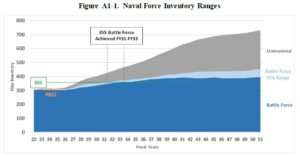
The Navy finally released its 30-year shipbuilding plan 10 months late, mapping out plans to massively increase the fleet to reach 355 manned ships within a decade and pushing past 400 ships by the 2050s. According to the plan, the service is planning on spending $147 billion from fiscal year 2022 to 2026 to procure 82 more ships, not counting unmanned vessels. Notably, by fiscal year (FY) 2025, the Navy plans to buy four Large Unmanned Surface Vessels per year,…

 By
By 











